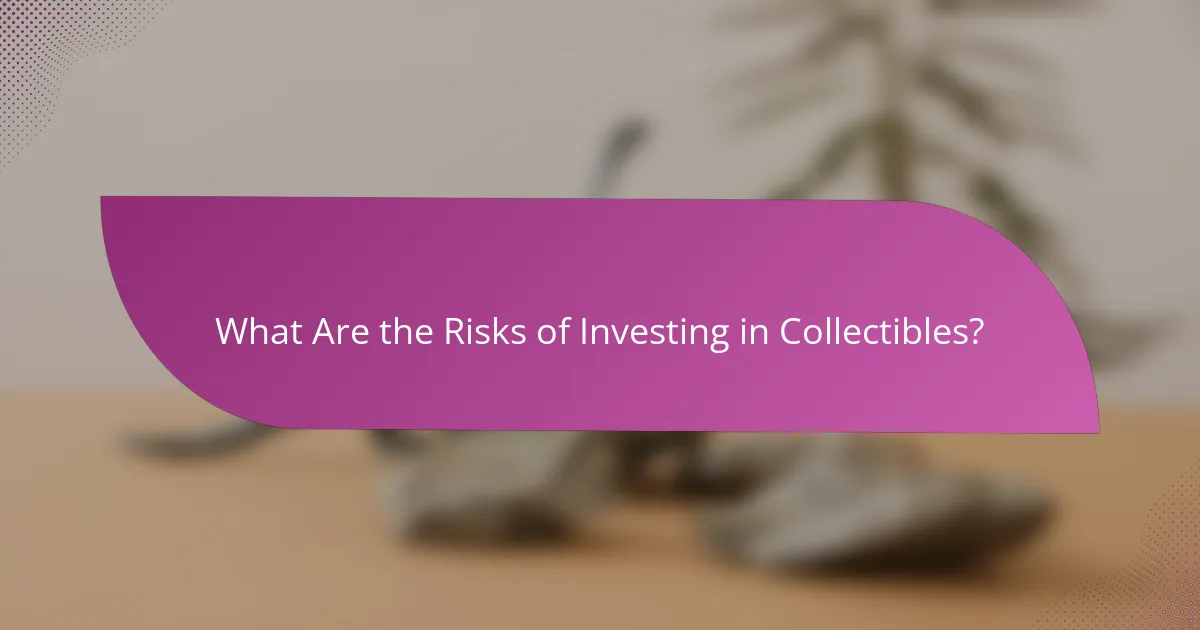Limited edition fandom collectibles are unique items produced in restricted quantities, often linked to popular franchises that ignite passionate fan enthusiasm. Their rarity and the fervor of collectors significantly drive their value and demand in the marketplace. Understanding factors such as condition, provenance, and market trends is essential for collectors aiming to navigate this vibrant and sometimes volatile market effectively.

What Are Limited Edition Fandom Collectibles?
Limited edition fandom collectibles are unique items produced in restricted quantities, often tied to popular franchises or fandoms. Their scarcity, combined with fan enthusiasm, drives their value and demand in the collectibles market.
Definition of limited edition collectibles
Limited edition collectibles are items that are intentionally produced in a finite number, making them more desirable to collectors. These items often feature exclusive designs, packaging, or features that distinguish them from regular versions.
The limited nature of these collectibles can create a sense of urgency among fans, as once they are sold out, they may not be reproduced. This exclusivity can significantly enhance their market value over time.
Examples of popular fandom collectibles
Popular fandom collectibles include action figures, art prints, vinyl records, and trading cards from franchises like Star Wars, Marvel, and Harry Potter. For instance, Funko Pop! figures often release limited edition variants that become highly sought after.
Other examples include signed memorabilia, such as autographed posters or scripts, which can fetch high prices at auctions. Limited edition video game releases with unique packaging or additional content also attract collectors.
Characteristics of limited editions
Limited editions typically feature distinctive characteristics that enhance their appeal. These can include unique serial numbers, special packaging, or exclusive artwork that sets them apart from standard items.
Additionally, the release of limited editions is often accompanied by marketing campaigns that emphasize their rarity, further driving demand. Collectors should be cautious, however, as not all limited editions retain value; factors like condition and market trends play a crucial role.

How Do Value and Rarity Affect Demand?
The value and rarity of limited edition fandom collectibles significantly influence their demand. Collectors often seek items that are scarce, as this scarcity can drive up both perceived and actual value in the marketplace.
Impact of rarity on collectible value
Rarity is a key determinant of a collectible’s value. Items produced in limited quantities, such as exclusive figures or special edition merchandise, tend to command higher prices. For example, a collectible that is limited to a few hundred pieces may sell for several times its original retail price due to its scarcity.
Collectors often prioritize items that are hard to find, leading to a competitive market. As a result, the more unique or limited an item is, the more likely it is to appreciate in value over time. This is particularly true for collectibles tied to popular franchises, where demand can skyrocket.
Market demand trends for collectibles
Market demand for collectibles fluctuates based on trends within fandom communities and broader economic factors. For instance, a resurgence in interest for a specific franchise can lead to increased demand for related collectibles, driving up prices. Seasonal events, anniversaries, or new releases can also significantly impact demand.
Monitoring online marketplaces and auction sites can provide insights into current demand trends. Collectors should pay attention to sales data, as well as community discussions, to gauge which items are gaining popularity. Engaging with fan communities can also help identify emerging trends and potential investment opportunities.

What Factors Determine the Value of Collectibles?
The value of collectibles is influenced by several key factors, including their condition, provenance, and current market trends. Understanding these elements can help collectors make informed decisions about buying, selling, or holding onto their items.
Condition and grading systems
The condition of a collectible significantly impacts its value. Items in mint or near-mint condition typically command higher prices than those with visible wear or damage. Grading systems, such as those used by professional grading services, provide a standardized way to assess and communicate the quality of collectibles.
For example, comic books are often graded on a scale from 0 to 10, with 10 representing perfect condition. A comic graded at 9.8 can sell for several times more than one graded at 7.0. Collectors should familiarize themselves with grading standards relevant to their specific collectibles.
Provenance and authenticity
Provenance refers to the history of ownership of a collectible, which can greatly enhance its value. Items with a well-documented history, especially those linked to notable figures or events, are often more desirable. Authenticity is equally crucial; counterfeit items can drastically reduce value.
Collectors should seek items with certificates of authenticity or reputable documentation. For instance, autographed memorabilia from celebrities should ideally come with proof of signature verification to ensure legitimacy.
Market trends and historical sales data
Market trends and historical sales data provide insight into the demand and potential future value of collectibles. Tracking auction results and sales figures can help collectors identify which items are appreciating in value and which are declining.
For example, limited edition collectibles from popular franchises often see spikes in demand during anniversaries or related media releases. Utilizing platforms that aggregate sales data can help collectors make strategic decisions about when to buy or sell their items.

Where to Buy Limited Edition Collectibles?
Limited edition collectibles can be found in various places, each offering unique advantages. Online marketplaces, local events, and specialty stores are popular options for collectors seeking rare items.
Online marketplaces for collectibles
Online marketplaces like eBay, Etsy, and specialized collectible sites provide a vast selection of limited edition items. These platforms often feature user ratings and reviews, helping buyers assess the reliability of sellers.
When purchasing online, be mindful of shipping costs and potential import duties, especially for international transactions. Always verify the authenticity of the collectible by checking seller feedback and return policies.
Local conventions and events
Attending local conventions and events is an excellent way to find limited edition collectibles. These gatherings often feature vendors specializing in fandom items, providing opportunities to buy directly from sellers and negotiate prices.
Keep an eye on the event schedule for exclusive releases or signings by creators, which can enhance the value of your purchase. Networking with other collectors at these events can also lead to valuable insights and trade opportunities.
Specialty stores and retailers
Specialty stores and retailers focusing on collectibles often carry limited edition items that may not be available elsewhere. These shops typically have knowledgeable staff who can provide guidance on the latest trends and releases.
Consider joining loyalty programs or mailing lists for these retailers to stay informed about upcoming releases and promotions. Shopping locally can also help you avoid shipping fees and support small businesses in your community.

How to Evaluate the Authenticity of Collectibles?
To evaluate the authenticity of collectibles, focus on verifying their provenance and condition. Authentic items typically come with documentation or certifications that confirm their legitimacy and value.
Identifying reputable sellers
When purchasing collectibles, it’s crucial to identify reputable sellers. Look for established dealers with positive reviews and a history of selling authentic items. Online platforms may provide seller ratings, while local shops often have a reputation within the community.
Consider joining collector groups or forums where members share experiences and recommendations. This can help you connect with trustworthy sellers and avoid potential scams.
Using certification services
Certification services play a vital role in verifying the authenticity of collectibles. These organizations assess items and provide certificates that confirm their legitimacy, often including details about the item’s history and condition.
Before buying, check if the item has been certified by a recognized service, such as PSA for sports cards or JSA for autographs. This adds a layer of security to your purchase, ensuring you are investing in a genuine collectible.

What Are the Risks of Investing in Collectibles?
Investing in collectibles carries several risks, including market volatility, authenticity concerns, and liquidity issues. The value of collectibles can fluctuate significantly based on demand, trends, and the overall economy.
Market Volatility
The collectible market can be highly unpredictable, with prices often influenced by trends, pop culture, and economic conditions. For instance, a limited edition item may see a spike in value during a particular event or anniversary but could drop significantly afterward.
Investors should be prepared for potential price swings and consider the long-term value rather than short-term gains. Researching market trends and historical sales can provide insights into potential volatility.
Authenticity Concerns
Authenticity is crucial when investing in collectibles, as counterfeit items can significantly diminish value. Buyers should seek items with verified provenance or third-party authentication to ensure they are purchasing genuine collectibles.
Investors should familiarize themselves with common signs of forgery and consider using reputable dealers or auction houses that provide guarantees of authenticity. Investing in collectibles without proper verification can lead to substantial financial losses.
Liquidity Issues
Liquidity refers to how easily a collectible can be sold for cash. Many collectibles can take time to sell, and finding the right buyer may require patience. Unlike stocks or bonds, which can be sold quickly, collectibles often require specialized marketplaces.
To mitigate liquidity risks, investors should consider the demand for specific items and their potential resale markets. Keeping track of similar items’ sales can help gauge how quickly a collectible might sell and at what price.
